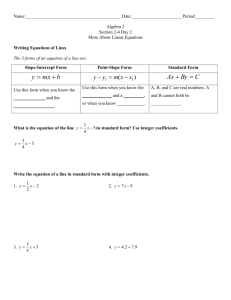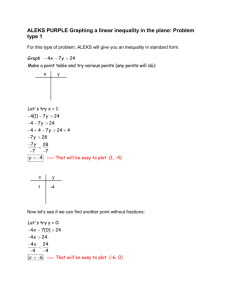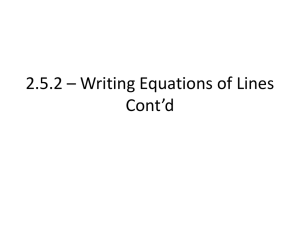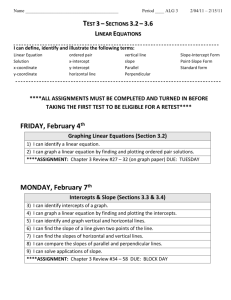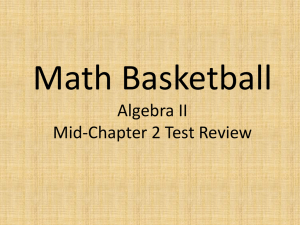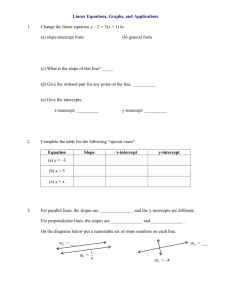Section 1.1: Learning Targets: I can identify if a number is irrational
advertisement
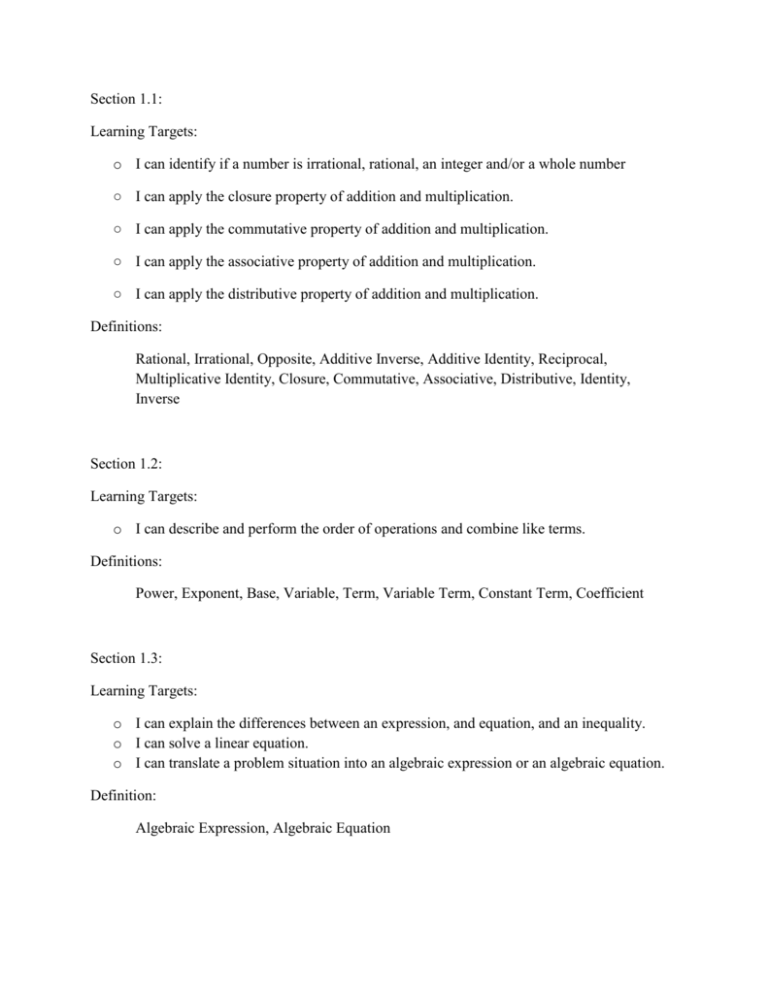
Section 1.1: Learning Targets: o I can identify if a number is irrational, rational, an integer and/or a whole number ○ I can apply the closure property of addition and multiplication. ○ I can apply the commutative property of addition and multiplication. ○ I can apply the associative property of addition and multiplication. ○ I can apply the distributive property of addition and multiplication. Definitions: Rational, Irrational, Opposite, Additive Inverse, Additive Identity, Reciprocal, Multiplicative Identity, Closure, Commutative, Associative, Distributive, Identity, Inverse Section 1.2: Learning Targets: o I can describe and perform the order of operations and combine like terms. Definitions: Power, Exponent, Base, Variable, Term, Variable Term, Constant Term, Coefficient Section 1.3: Learning Targets: o I can explain the differences between an expression, and equation, and an inequality. o I can solve a linear equation. o I can translate a problem situation into an algebraic expression or an algebraic equation. Definition: Algebraic Expression, Algebraic Equation Section 1.4: Learning Targets: o I can manipulate a formula to solve for a particular variable. Definition: Formula Section 1.5: Learning Targets: o I can translate a problem situation into an algebraic expression or an algebraic equation. Definition: Verbal Model Section 1.6: o I can solve a linear and/or compound inequality and graph the solution set. Definition: Less Than, Greater Than, Linear Inequality, Compound Inequality, Equivalent Inequality, Less Than or Equal to, Greater Than or Equal to Section 1.7: o I can evaluate if a solution is extraneous. o I can solve a linear equation or inequality involving absolute value. Definition: Absolute Value, Extraneous Solution Section 2.1: Learning Targets: o o o o I can write an equation or inequality in two variables using the input and output values. I can identify if an ordered pair, a table, a graph or a mapping diagram is a function. I can apply the vertical line test to determine if a graph is a function. I understand how to use function notation when writing a linear equation. Definitions: Relation, Domain, Range, Function, Independent Variable, Dependent Variable, Linear Function, Function Notation Section 2.2: Learning Targets: o I know the difference between positive slope, negative slope, zero slope and undefined slope. o Given two slopes, I can determine if the lines are parallel, perpendicular, or neither. o I can calculate the slope of a line given two points. o I can calculate the rate of change and determine how it relates to slope. Definitions: Slope, Parallel, Perpendicular, Rate of Change, Discrete Function, Continuous Function Section 2.5: Learning Targets: o I can identify if a graph, table or an equation represents direct variation. o I can write a direct variation equation given an ordered pair (x, y). Definitions: Constant Variation Section 2.8: Learning Targets: o When graphing a linear inequality, I know whether the boundary line is solid or dashed and I know which side of the boundary line to shade. o I can graph a linear inequality into two variables. Section 2.3: Learning Targets: o I can explain what happens to the parent function when the slope and y-intercept change. o I can write an equation for a line in slope-intercept form, point-slope form, and standard form. o I can identify the slope and y-intercept of a line from the equation and the graph. o I know how to determine if an ordered pair (x, y) is a solution to an equation in two variables. o I understand how to write equations for horizontal and vertical lines. o I can convert an equation from slope=intercept form and point-slope form into standard form and vice versa. o I can graph a linear equation. o I can graph an equation using slope intercept from. o I can graph horizontal and vertical lines. Definitions: Parent Function, X-intercept, Y-intercept, Slope-Intercept Form, Standard Form, Horizontal Lines, Vertical Lines Section 2.4: Learning Targets: o I can write an equation for a line in slope-intercept form, point slope form, and standard form. o I can write an equation for a parallel or perpendicular line, given the equation of a different line. o I can convert an equation from slope-intercept form and point-slope form into standard form and vice-versa. Definitions: Point-Slope Form
